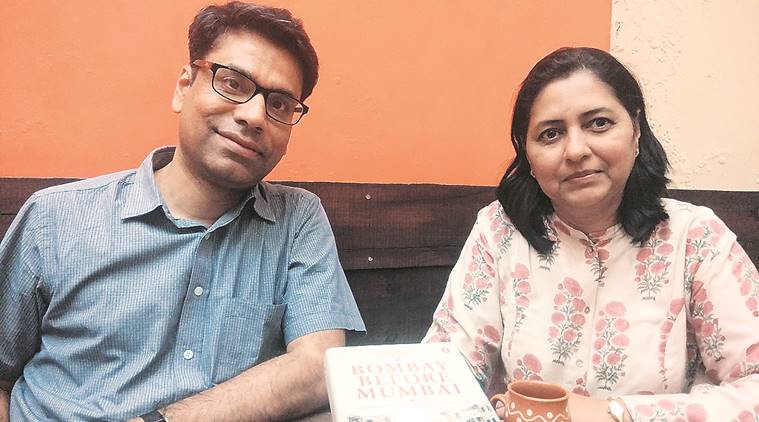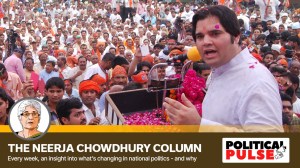- India
- International
‘Mumbai is not just a mosaic of India but of world’
The book has been curated in tribute to noted urban historian Dr Jim Masselos, who has written extensively on Mumbai.
 Prashant Kidambi (Left), Manjiri Kamat.
Prashant Kidambi (Left), Manjiri Kamat.
Prashant Kidambi, associate professor of colonial urban history, University of Leicester, and Dr Manjiri Kamat, associate dean of humanities, Mumbai University, discuss their book Bombay Before Mumbai, also co-authored by Professor Rachel Dwyer of SOAS London. The book has been curated in tribute to noted urban historian Dr Jim Masselos, who has written extensively on Mumbai. The book, to be released on January 7, comprises essays from scholars across the world on the themes Masselos explored as part of his works. They discuss the significance of Masselos’ work with Abha Goradia. Excerpts:
How did three faculties from three continents come together to curate this book?
Manjiri Kamat (MK): After I became the head of department for history at Mumbai University, with the help of the then vice-chancellor and pro vice-chancellor, we initiated the idea of hosting an international conference titled ‘Power, public culture and identity: Toward new histories of Mumbai’ in January 2017. At the conference, we had young as well as senior scholars in attendance, who knew about Jim’s work and the themes he had worked on. It aroused a lot of interest in the academic community. After the conference, Professor Dwyer urged us to take this forward in the form of a book. University of Leicester has started a Centre for Urban History and Dr Kidambi and I knew each other. That’s how the three of us came together for the book. We were also glad to find three different publishers in the three countries who were keen. While the book has been released in London and New York, its India release is in Mumbai on January 7 at CSMVS (Chhatrapati Shivaji Maharaj Vastu Sangrahalaya).
How would you describe Jim Masselos’ work?
Prashant Kidambi (PK): Jim is a historian, well-known and indispensable to the study of Bombay. He came to Bombay in 1961 as a Commonwealth scholar and wrote actively on the city for six decades. He provided insights into how communities were formed, how people sought to pursue politics. This longevity, productivity and prolific work needs to be honoured. Jim has been closely related to institutions in the city. We don’t have a tradition of honouring those who have worked before us. We wanted to pay him a tribute though none of us are his students.
MK: Community, space, power, nationalism are important themes in Jim’s writings. Jim’s work starts in the 1960s, and he has written about various aspects in a way no one else has. He continued to write till the 90s and is distinguished in the field of urban history. While many Indian students go abroad for PhD, Jim showcased a reverse trend. He came from Sydney to Mumbai to finish his PhD in History from St Xavier’s College. Jim knew the nooks and corners of the city. He has seen Mumbai metamorphosing over the years, engaging with life on the streets and even followed protocol of archives. He wrote about the contribution of the aam aadmi much before subaltern studies came up. People then didn’t write about power relations in the neighbourhoods of Mumbai.

Could you tell us about the contributors of the book?
MK: This book features 13 essays of scholars from around the world on different facets of Mumbai, on themes that were explored in Jim’s writings. Eleven of them were part of the international conference at MU, while two other scholars, who could not make it to the conference, were invited to contribute. We chose from the papers presented, asked scholars to refine their work and give a thought to themes Jim has engaged with during his lifetime. Murali Ranganathan sheds light on the life and times of a Bombay Country trader, whereas Simin Patel has written about the great Persian famine of 1871, Parsi refugees and the making of the Irani identity. Douglas Haynes has written about Bombay’s European community during the inter-war period. Erica Wald writes about the life of Bombay theatre. Bombay’s shops have found focus in the essay by Abigail McGowan in her essay on marketing home furnishings in late colonial Bombay. Vanessa Caru has focused on workers’ housing and social control. Apart from that, Jim has contributed an essay himself.
What is the one thing that makes this book unique?
MK: There is no book right now that brings together doctoral work and that of historians’. This book also caters to an avid reader or a tourist who wants to read how Mumbai has changed so fast. There are some facets of Mumbai we may not be able to see. The role which Parsis have played, the contribution of Muslims, the evolution of Kamathipura and other red light districts, the beginning of Mumbai as an industrial city ? these are some themes rarely known of.
PK: We took up each aspect Jim wrote about, and each writer critically and creatively dealt with these aspects. We hope this project is a provocation for more such work. Even though the book is academically researched, it has been addressed to normal readers. It is an example of how urban history in India is coming into its own.
What were some of the challenges you encountered? What are your views on Mumbai as a historian?
PK : Many of our city’s repositories are facing crisis. We need to protect our visual, audio photographic, archival sources which are heading towards steady depletion. We found that a majority of the material resources were in a poor condition. Digitisation is happening, but in a haphazard manner.
MK: The best of the city’s past needs to be preserved. It is worrying that slowly the street food, Udupi joints, are giving way to outlets of international brands. Mumbai is not just a mosaic of India but of the world.
Apr 24: Latest News
- 01
- 02
- 03
- 04
- 05







































